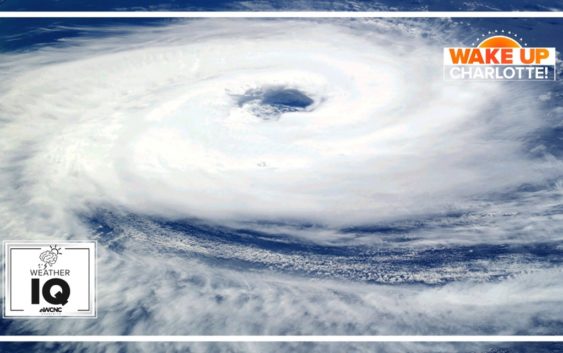- Western NC neighborhood still reeling from Hurricane Helene flood damage
- Ashe County Schools reopen after Hurricane Helene hit area over a month ago
- Ashe County Schools reopen Tuesday after Hurricane Helene hit area
- Carolina Hurricanes foundation donates $50,000 to rebuild Asheville hockey rink
- Stress, shelter, and safety: Hurricane Helene's effect on domestic violence victims in NC
Weather IQ: The history of Category 5 hurricanes in the Atlantic

There have now been 40 category five hurricanes in the Atlantic Hurricane history. Here is the history of these incredible and catastrophic storms.
CHARLOTTE, N.C. — Since 1924 (so roughly over the past 100 years), the Atlantic Basin and Caribbean has recorded 40 category 5 hurricanes. Where 2023’s Hurricane Lee officially became the 40th. So let’s learn more about the history of category 5 hurricanes and their history.
First, let’s start with the basics: Hurricanes are ranked into 5 categories via the Saffir-Simpson Scale (first created in the early 1970s and was adjusted in 2012). For a hurricane to reach category 5 status, it must have sustained winds of 157 mph or higher.
The History of category 5’s.
Hurricane record keeping dates as far back as 1842 but the FIRST category 5 wasn’t documented until 1924.
This hurricane made landfall in extreme western Cuba with sustained winds of 165 mph. This is one of two CAT 5’s to make landfall in Cuba. (The other was 2017s Hurricane Irma).
The first 9 Cat 5’s from 1924 to 1944 were unnamed since hurricanes didn’t get named until 1950. Before then, epic landfall hurricanes would get a nick-name based on where they created damage or loss of life.
- 1924 – “The Great Cuba Hurricane of 1924”
- 1928 – “SAN FELIPE-OKEECHOBEE“
- 1932 – “The Great Bahamas Hurricane of 1932”
- 1932 – “The Great Cuba Hurricane of 1932”
- 1933 – “Cuba–Brownsville”
- 1933 – “Tampico”
- 1935 – “Labor Day Storm of 1935”
- 1938 – “The New England Hurricane”
- 1944 – “Great Atlantic Hurricane”
The Cat 5’s to make U.S. landfalls:
The first Category 5 made landfall in the United States was the 7th category 5 on record. This storm is known as the “Labor Day storm of 1935.” It made landfall in the Florida Keys with winds of 185 mph, the strongest storm to make landfall in the US.
Hurricane Camille in 1969 is the second strongest landfalling hurricane in the U.S., hitting southern Mississippi with 175 mph sustained winds.
1992’s Hurricane Andrew is infamous to Florida. The strongest to hit the state and scarred the Miami area with 165 mph winds.
Hurricane Michael in 2018, devastated the Florida panhandle, especially Mexico Beach with 160 mph.
Category 5 hurricanes to make landfall in other countries:
There are multiple hurricanes that have made landfall at category 5 strength outside of the United States.
- Great Cuba Hurricane of 1924 (Western Cuba – 1924)
- San Felipe Hurricane (Southeast Puerto Rico – 1928)
- Great Bahamas Hurricane (Northern Bahamas – 1932)
- Hurricane Janet (Southern Quintana Roo, Mexico – 1955)
- Hurricane Inez (Southern Dominican Republic – 1966)
- Hurricane Edith (Northern Nicaragua – 1971)
- Hurricane Anita (Eastern Tamaulipas – 1977)
- Hurricane David (Southern Dominican Republic – 1979)
- Hurricane Gilbert (Cozumel and Playa Del Carmen, Mexico – 1988)
- Hurricane Dean (North of Belize – 2007)
- Hurricane Felix (Northern Nicaragua – 2007)
- Hurricane Irma (Northern Cuba – 2017)
- Hurricane Maria (Dominica – 2017)
RELATED: What month has the most hurricanes?
Interesting Cat 5 Stats/Facts:
- Hurricane Allen (1980) tops the list as the strongest hurricane sustained at 190 mph.
- Hurricane Dorian in 2019 was the slowest moving category 5, remaining stationary for over 14 hours in parts of the Bahamas
- Of the 39 category 5 hurricanes (before Lee), only three haven’t been retired: Lorenzo (2019), Edith (1971) and Esther (1961).
- Hurricane Wilma recorded the lowest pressure of any Atlantic Hurricane. 882 mb was recorded in 2005.
- 2005 had the most Category 5 hurricanes in a single season and one of those was Katrina. RELATED: Hurricane Emily: The storm that refuses to be retired (2005’s Cat 5 that wasn’t retired)
Lastly, Category 5 hurricanes are becoming more common. Sixteen CAT 5s, have formed since 2003. And eight of those have been over the last eight years.